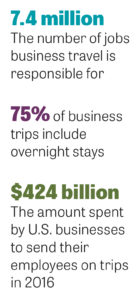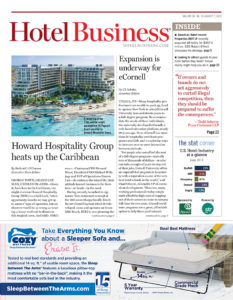BOSTON—It’s no secret that travel and tourism stimulates the economy, aiding gains in GDP growth and contributing countless jobs to the U.S. economy. And business travel is an integral part of the hospitality business and the tourism economy—and a new report highlights just how critical this sector is.
Last month, the GBTA Foundation, the education and research arm of the Global Business Travel Association, and American Express Global Business Travel released “The U.S. Business Travel Economic Impact Report,” a study that underscores the benefits for the U.S. economy that business travel creates.
Among the key findings? Business travel was responsible for $547 billion in U.S. GDP in 2016, which amounts to about 3% of the overall GDP. In a time when there’s a lot of uncertainty around government regulations that could either help or hinder the growth of travel and hospitality nationwide, it’s clear that business travel is a critical component to the nation’s economic health. For instance, the study found that for every 1% change in business travel spending, the U.S. economy gains or loses 74,000 jobs, $5.5 billion in GDP, $3.3 billion in wages and $1.3 billion in taxes.
The study also found that the business travel industry is responsible for some 7.4 million jobs and $135 billion in taxes at all levels of government. While the major benefits of business travel go to businesses that have direct interaction with business travelers, the study did find that $132 billion did go indirectly to supply chain beneficiaries as well.
 To break it down further, in 2016, there were 514.4 million domestic business trips, resulting in $424 billion being spent by U.S. businesses to send their employees on trips. However, the study did find that the average amount spent per business fell 2.2% in 2016. The average trip cost $520: This includes $163 spent on lodging, $180 on transportation, $94 on food and beverage, $33 on entertainment and $50 on shopping and merchandise. (This includes both domestic and international inbound trips, as well as both day and overnight trips.)
To break it down further, in 2016, there were 514.4 million domestic business trips, resulting in $424 billion being spent by U.S. businesses to send their employees on trips. However, the study did find that the average amount spent per business fell 2.2% in 2016. The average trip cost $520: This includes $163 spent on lodging, $180 on transportation, $94 on food and beverage, $33 on entertainment and $50 on shopping and merchandise. (This includes both domestic and international inbound trips, as well as both day and overnight trips.)
Certainly, the vast majority of business trips were overnight stays—accounting for roughly 75% of travel, according to the survey. Almost 40% included a one- to two-night stay, 22% included three to four nights and 14% included trips lasting more than five days.
The study also analyzed why the business trips took place. The largest portion—48%—were transient trips, such as sales meetings, client services, construction or repair work, as well as government and military travel. Group travel accounts for 28% of the trips, and the remaining 25% were bleisure trips—a combination of both business and leisure travel.
One of the biggest question marks in the industry in recent times has been the impact of alternative accommodations like Airbnb, which, thus far, has made the majority of its gains in the leisure market. However, Airbnb and others have implemented measures to attract business guests to home-sharing alternatives. According to the study, hotels remain the most popular accommodation type for business travelers, with 42% of business travelers choosing to stay in traditional hotels. Some 18% did stay in other accommodations, including bed & breakfasts and sharing economy spaces.
Where do travelers go? Primarily to areas in the U.S. with large populations and large business centers. Roughly 94% of money spent on business travel was disbursed domestically, specifically to states in the Pacific region, Northwest, Southeast and Central and Mountain states like Illinois, Michigan, Texas and Colorado.
In recent years, there’s also been a large focus on the changing business traveler. No longer will this guest settle for a bed and a cup of coffee—business travelers want fast and efficient technology and personalized service in addition to all of the comforts from home. The industry has adapted, instituting changes for those with a millennial mindset. But while the millennial generation is something to prepare for, it hasn’t taken over business travel just yet. Roughly half of business travelers are under the age of 45, while the other half is over the age of 45. Additionally, nearly 60% are married, more than 60% are men and business travelers have an average household income of just over $82,000. More than one-third have a bachelor’s degree and fewer than one-third have a graduate or professional degree. HB

